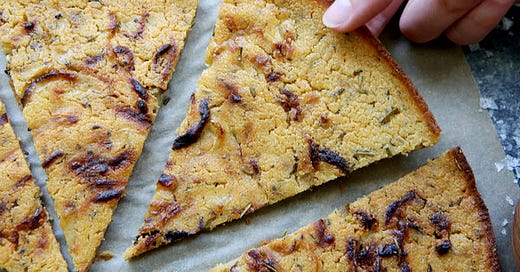Socca Is an Addiction
Once you decide on the pan and flour you'll use, there's a good chance you'll make it all the time
I first went to Nice in 1992. It was a charmed trip to eastern Provence, filled with Matisse and lavender and sunlight and … socca. Someone — I wish I could remember who – said, “You can’t go to Nice without getting socca – central outdoor market, every morning.”
So I walk over there on my first morning. There looks to be what might be a socca stand – or certainly, it’s a stand with little besides scissors and some waxed paper and a couple of salt and pepper shakers – but there’s no socca.
A bike appears. The rider is carrying a socca. The woman at the stand grabs it, cuts it up with the scissors, sprinkles pepper all over it, starts putting messy sections – these are not nice neat triangles, like pizza, but bits and pieces, some big, some small – in sections of paper. She hands them out and takes a euro, or whatever it was then. The bike is long gone, to return in ten minutes with another. Turns out, the oven isn’t in the market, but in a side street nearby: a tiny hole in the wall where they pump out the socca and don’t even sell it — they just give it to the bike guy.
Socca is a big pancake, made with chickpea (and sometimes fava) flour, water, olive oil, onion, and usually a load of black pepper and some rosemary. You just make a thin batter, season it, put some oil into a socca pan – the best are of lined copper – and then pour in the right amount of batter, mixed with the other ingredients. You bake it until the edges are crisp and the center quite dry. It’s the best.
They make it right across the border in Liguria, too, where it’s called farinata or, in dialect, faina. My friend Luciano took me to his uncle’s house about ten years later, and that guy had an outdoor kitchen, but not a fancy one – an old one. He, too, made one faina after another, and people stood around eating them like they’d never get another. His was incredible – more onion than the one at the stand in Nice and so much black pepper you would gasp and your mouth tingle.
They make it right across the border in Liguria, too, where it’s called farinata or, in dialect, faina. My friend Luciano took me to his uncle’s house about ten years later, and that guy had an outdoor kitchen, but not a fancy one – an old one. He, too, made one faina after another, and people stood around eating them like they’d never get another.
They’re so easy to make at home. It used to be that you had to go to (mostly) Indian markets to get chickpea flour (besan), but now Bob’s Red Mill sells it, and fava bean flour, and a mixture of the two, and so do many other people. (I do like the combo, and this is all very similar to falafel, a close but obviously fried cousin.)
Years ago, Kerri and I started making mock socca with different flours – because, after all, it’s just a big thin pancake. Wheat is good: buckwheat, too. There are undoubtedly traditions in using these, not for socca/farinata, but for similar roasted pancakes elsewhere.
Last night, I did it with purple barley, which was local (and given to me by Glynwood’s resident grain genius, June Russell) – and it was sensational.





